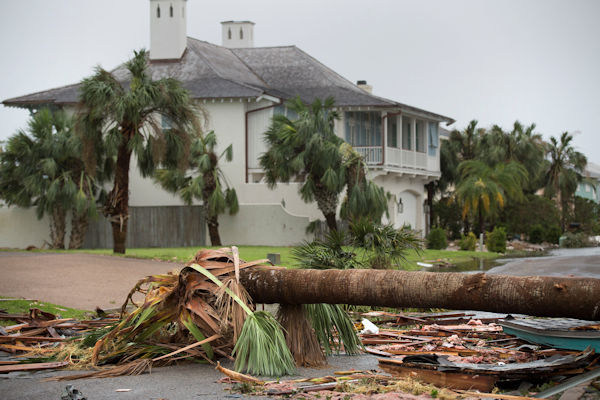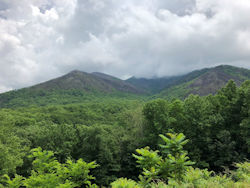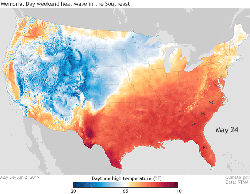SEJournal Online is the digital news magazine of the Society of Environmental Journalists. Learn more about SEJournal Online, including submission, subscription and advertising information.
 |
 |
| Property damage in Rockport, Texas, in the wake of Hurricane Harvey, Aug. 26, 2017. Harvey spurred the worst flooding in U.S. history. Photo: U.S. Customs and Border Protection/Glenn Fawcett, Flickr Creative Commons. Click to enlarge. |
Covering Your Climate: Crisis Threatens the Country’s Most Vulnerable Region
This Society of Environmental Journalists’ special report — “Covering Your Climate: The South” — is the second in a series designed to help journalists of all kinds cover the impacts of climate change in their region, and to report on actions taken to mitigate its worst effects and preparations for what can’t be stopped. Below is part two of the special report, a tipsheet with a closer look at anticipated impacts. In the coming weeks, we’ll also publish a resource toolbox and two more tipsheets with a wealth of story ideas for right now, and over the coming decade. Meanwhile, check out our backgrounder overview. The project is distributed through SEJournal and the independent, nonprofit media organization Southerly, which covers the intersection of ecology, justice and culture in the American South. Southerly's Lyndsey Gilpin served as regional editor for this special report.
By Elizabeth Ouzts
By nearly every measure, the Southern United States is the country’s most vulnerable in the face of the climate crisis.
This part of the country is already warm, humid and predominantly coastal, so extreme heat, drought, wildfires, coastal flooding and inland flooding will have outsized impact. In fact, an analysis of Climate Central data found that nine of the 10 states in the country most at risk from these effects are in the South.
Storm surges and rising seas threaten the Gulf and Atlantic coasts, along with some of their most iconic cities: New Orleans, Miami, Charleston. Extreme flooding is ravaging the hills of Appalachia.
Heat waves are expected to grip the region’s rapidly growing urban areas, exacerbating health-threatening air pollution that disproportionately impacts poor people and communities of color.
In rural agricultural and fishing communities,
intense heat and flooding will decrease crop yields
and seafood catches, while heightening disparities
in health care, income and education levels.
In rural agricultural and fishing communities, intense heat and flooding will decrease crop yields and seafood catches, while heightening disparities in health care, income and education levels.
Vector-borne diseases that thrive in warm, wet environments, such as West Nile and Zika, are expected to proliferate in the South more than anywhere else.
Drought, punctuating extreme rains that allow forest understory to flourish, will increase the chance of wildfires. At the same time, higher temperatures will decrease the number of days when prescribed burns — the usual method of fire control in the region — can be executed.
With more people living closer to forested land, more lives will be at greater risk. Texas is the most vulnerable state in the country, according to Climate Central, with 18 million people living in this wildland-urban interface. By 2050, Arkansas, Alabama, Louisiana and Mississippi will all face above-average wildfire risk.
GDP could dive, residents could flee
With its economy so dependent on tourism and agriculture, the South could see a 10-20 percent loss in gross domestic product (may require subscription) if warming continues unchecked, some studies predict — a greater hit than any other region.
Those with the means will move elsewhere as “the bottom half of the country grows inhospitable, dangerous and hot,” wrote ProPublica’s Abrahm Lustgarten for the New York Times Magazine (may require subscription) in September 2020.
A tenth of all residents from South Carolina to
Alabama to Texas will move north, many a subset
of the roughly 13 million Americans who will
move from the coastline to escape rising seas.
A tenth of all residents from South Carolina to Alabama to Texas will move north, many a subset of the roughly 13 million Americans who will move from the coastline to escape rising seas.
Many Southern states have already begun to suffer from severe weather linked to the climate crisis, usually in the form of major storms.
In 2017, Hurricane Harvey spurred the worst flooding in U.S. history, dumping well over two feet of rain in some areas and leaving nearly a third of the country submerged in floodwaters. Hurricanes Matthew and Florence hit eastern North Carolina just two years apart.
Florida Panhandle communities are still rebuilding from Hurricane Michael three years later, and Louisiana was hit by Hurricane Laura just around the 15th anniversary of Katrina. Less than two months later, the state began bracing for Delta, its sixth hurricane of the year. In the last 40 years, the South has been affected by more billion-dollar disasters than any other region.
Heat waves, toxic risks
Climbing temperatures are not as headline-grabbing, but can be just as serious.
 |
| An area of Great Smoky Mountain National Park that was burned by a massive wildfire in 2016. Photo: Lyndsey Gilpin. Click to enlarge. |
Sixty-one percent of major Southern cities are experiencing worsening heat waves, a higher percentage than in any other region, according to the 2018 National Climate Assessment. Birmingham, New Orleans and Raleigh are already experiencing longer, more frequent, more severe heat waves, especially in the form of nights that don’t dip below 75 degrees.
Decades of racist housing policies in the form of redlining (may require subscription) have left Black neighborhoods hotter than white neighborhoods in cities like Richmond.
Other risks connected to fossil fuel dependency weigh heavy on the South.
Open coal ash pits are perched on every major river in the region, where they can overflow and leak toxic substances into groundwater. Mountaintop removal and coal mining risk toxic pollution leaching into Appalachian streams.
Also, oil drilling off the Gulf Coast and fracking in West Virginia create water, soil and air pollution, as well as both chronic and major toxic spills. And more than 100 coal-fired power plants — the largest fleet in the country — continue to create smog- and soot-forming pollution across the region.
Journalists struggle to inform inhabitants
There’s plenty of breathless coverage of the biggest climate catastrophes confronting the South right now: the television correspondent reporting in a company windbreaker, battling gusts of wind and sheets of rain, could be the most tired trope in local journalism.
But while some national news outlets like the New York Times and several climate-focused news outlets are increasingly connecting these events to the climate crisis, it is still far from standard practice.
An analysis of 2019’s network broadcast coverage of Hurricane Dorian — the fourth Category 5 storm to form in the Atlantic Ocean in four years and one of a string of storms to batter the North Carolina coast — found that just one segment out of 216 on the three major networks mentioned global warming.
 |
| A heat wave hit the South with record-breaking temperatures Memorial Day Weekend 2019. Image: NOAA. Click to enlarge and see animation. |
There’s little doubt that events like Dorian are linked to the warming planet: It isn’t necessarily causing storms, but it is making them wetter, windier, probably slower (may require subscription) and therefore more devastating. Scientists estimate the climate emergency caused Harvey to dump 40% more rainfall than it would have otherwise.
Yet some of those most impacted by these events are least educated about them. People living in red and purple coastal counties in North Carolina — one of the most hurricane-prone states in the country — are less likely than those in bluer, urban, inland counties and the state overall to believe global warming is happening, according to a Yale University survey.
Residents of Louisiana, the state third most likely to be hit by hurricanes, are less alarmed by the climate crisis than the nation as a whole.
Reporters in inland states like Arkansas and Kentucky, who are often in shrinking newsrooms without environmental reporters, are left to do the difficult work to connect the dots for their audience, to show how water shortages, flooding or even economic downturns are predicted to worsen in a warming world.
Some editors still shy away from stating climate science as fact: a recent, well-reported piece in the Raleigh News & Observer about how a warming planet would increase risk of wildfire in North Carolina ran in the opinion section.
The news media tend to report on the immediate impacts of environmental crises like coal ash disasters and oil well explosions, but rarely look at the long-term effects of a broken disaster aid system or how climate change intensifies inequities.
In North Carolina, for instance, flooding from Hurricanes Matthew and Florence caused coal ash pits to burst and overflow into lakes and rivers. In the winter of 2020, eastern Kentucky saw days of heavy rainfall that caused floodwaters to take out bridges and roads, and leave many without safe drinking water.
In an era of intense tribalism and deep partisan divides on the issue, it has never been more important to educate viewers, listeners and readers about how the warming planet connects to current catastrophe.
That means providing context from climate scientists. It means telling the stories of and amplifying the voices of those most impacted. It means covering not just the immediate effect of a hurricane or a heat wave but following up to see what chain reaction it caused.
Above all, it means reporting with authority and urgency that these problems are not some theoretical future occurrence. They are already upon us.
 |
Based in Raleigh, North Carolina, Elizabeth Ouzts covers the state’s clean energy transition for the Energy News Network, a role she’s held since 2016. Her writing has also been featured in Environmental Health News. A former director of communications for the nonprofit Environment America, Elizabeth brings nearly two decades of experience in environmental and energy policy to her reporting.












 Advertisement
Advertisement 



